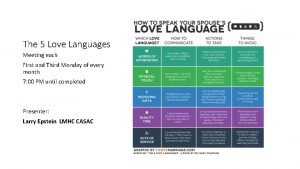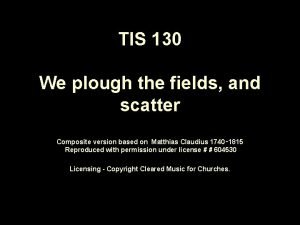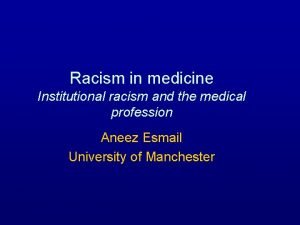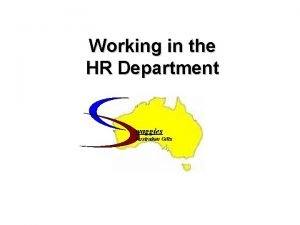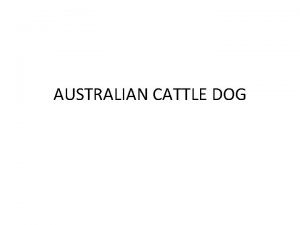Safety in the Swaggies Office waggies Australian Gifts



































































- Slides: 67

Safety in the Swaggies Office waggies Australian Gifts Follow Workplace Safety Procedures Unit BSBCMN 106 A Follow Environmental work procedures Unit BSBCMN 109 A

What is Workplace safety? Maintaining the health, safety and welfare of employees and others in all workplace environments

On successful completion of this unit you will be able to Ø Recognise and report any workplace hazard Ø Comply with procedures to assess and control risks Ø Follow workplace procedures in emergencies Ø Contribute to safety in the workplace through consultation with employers, employees, OHS representatives.

OHS has a long history Ø OHS was recognised in the late 1700’s in Britain. Nothing meaningful was done about it. Ø During the 1800’s and through the depression years of the early 1900’s and through the years of WW 1, WW 2, there were many people who were out of work and desperately took whatever work could be found no matter what the conditions.

Ø In the 1970’s Australian governments (State and Federal) made OHS an issue and put in place legislation that covered the health and safety of all workers in all occupations - The Occupational Health and Safety Act, 1983. This is now the Occupational Health and Safety Act, 2000.

Is the Australian workplace hazardous? Ø The Australian National OHS Commission estimates – 650, 000 Australian work injuries per year • that’s 1 worker in 12 • 1 in 5 workers need more than 5 days to recover – 2, 900 work-related deaths each year • that’s nearly 1 ½ times the number of fatal road accidents a year

Is the workplace hazardous worldwide? Ø The World Health Organization estimates – 250 million accidents occur each year – 330, 000 deaths – 160 million occupational diseases

Accidents and Injuries can be costly Lost production Absenteeism Medical bills Increased Work. Cover or insurance premiums Ø Unwanted publicity Ø Ø Ø Replacement or repair of damaged equipment Ø Training of new or casual staff Ø Poor company image Ø Fines or prison!

What are some typical workrelated injuries? Ø Bad backs (lifting) Ø Ø Lung diseases (breathing toxic Ø chemicals) Ø Burns Ø (hot machinery parts) Ø Hearing loss Ø (noisy machinery) Cuts (sharp construction tools) Crushing injuries (moving objects) Skin diseases (irritating substances) Broken bones (falling)

Work. Cover Authority of NSW Ø The statutory authority that administers OHS legislation in NSW Ø Provides advice on rights and responsibilities concerning OHS, rehabilitation and workers compensation Ø Investigates causes of accidents, injuries and illnesses Ø Issues licenses for hazardous operations, eg. for the handling of dangerous chemicals

What is the National Occupational Health Safety Committee? Federal authority that considers the laws, regulations and procedures covering health and safety to all workers.

Whose responsibility is workplace safety? Employers and Employees are both responsible

Employer’s Responsibilities EMPLOYERS have a ‘duty of care’ (by law) to provide a safe workplace. Ø Managers and supervisors MUST help employers meet this responsibility. Ø Consult with employees on OHS matters Ø Assess likely hazards Ø Control and minimise hazard risks Ø Provide information to workers

Employer’s Responsibility con’t Ø Consult with workers (through OHS reps and committees) Ø Organise safe work systems Ø Improve understanding (by instruction/training) Ø Provide protective clothing and equipment

Employer’s Responsibility con’t – Ensure tools/equipment/machines are safe – Supervise inexperienced workers – Monitor the workplace – Keep records of inspections and injuries

Training Employers MUST provide: Ø Training to OHS representatives and Committee members Ø Training to all workers to ensure Health and safety

Employee’s responsibility • EMPLOYEES (YOU) must take care of your own safety and that of others who may be affected by your actions. You MUST co-operate with your employer. Ø Work/behave in a safe way Ø Take care not to endanger the safety of others Ø Follow employer instructions Ø Operate equipment safely and only for the intended purpose Ø Use personal protective equipment

Employee’s responsibility con’t Ø Cooperate with your employer Ø Do not willfully/recklessly interfere or misuse equipment Ø Ensure you are not affected by alcohol or drugs Ø Report hazards Ø Report work-related injuries, near misses

Recognise and report workplace hazards

What is a hazard? A hazard is something that has the potential to cause harm. This harm can affect people by causing injury, illness, death or psychological trauma. Website: www. nohsc. gov. au

WORKPLACE HAZARD WORK ACTIVITY Drilling a hole; Typing a letter Unloading cargo Moving a heavy object SITUATION Tripping over a cord; Wet floor in a foyer ARRANGEMENT Poor storage techniques PRODUCTION PROCESS Toxic fumes; excess heat

Checklist of Hazards in the Working Environment Date: Area: What to look for: Look at all areas and compare to the standards provided below. Some aspects may not be applicable. A "no" response to any question indicates an area that will need further assessment. PASSAGEWAYS FUMES/VENTILATION EXIT/EGRESS ERGONOMIC FACTORS NOISE LAYOUT (of workplace) LIGHTING .

What should you report? Ø Any event that results in injury or disease - no matter how minor - is reportable Ø Dangerous occurrences or events including a near miss that endangers the health or safety of a person Ø Any event that results in death Employees have a LEGAL RESPONSIBILITY to report any accident or incident

Who do you Report Hazards to? Your Supervisor OHS Committee ØSupervises New Employees ØCoaches and mentors team members ØCommunicates between senior management and workgroups Ø Formal body that resolves OHS issues Ø Reviews OHS measures Ø Investigates OHS matters Ø Solves OHS problems Ø Develops OHS policies, procedures and programs Ø Comprises both employees and employer representatives Must be established when >20 employees

Who do you report hazards to? OHS Representative Ø Ø Ø Elected to represent designated workgroups Review OHS measures Conduct inspections Accompany an OHS inspector Provide input into development of OHS systems and emergency preparedness procedures Ø Know about particular hazards Ø Keep up-to-date with information injuries and health Ø Communicate with management/workers about changes Ø Make recommendations about training Must be elected even if requested by only one employee

Comply with procedures to assess and control risks In an Office Environment

Hazard Categories The FOUR categories of hazards we will look at are: 1. Physical Hazards, eg OOS, posture 2. Manual Handling hazard, eg lifting 3. Chemical Hazard, eg Toxic substances 4. Psychosocial Hazard, eg Stress

What are the FOUR steps to identify and control a hazard Ø Identify the hazard – what is it Ø Assess the risks – what is likely to happen Ø Control the risks – preventative measures Ø Evaluate the solutions – were the preventative measures: Ø Ø appropriate successful

Let’s take a closer look at Occupational Overuse Syndrome Ø Ø What is it? o OOS relates to the repetitive use of the same muscles over an extended period of time What does it affect? o Muscles o Tendons o Soft tissues in the neck, back, shoulders, hands, fingers, wrists, elbows

Who does OOS affect? Ø Office workers Ø Cleaners Ø Hairdressers Ø Kitchen workers Ø Drivers Ø Mail sorters Ø Painters Ø Musicians Ø Process workers on assembly lines (packers, sorters, pressers) Ø Construction workers (bricklayers, carpenters, plumbers and tilers) Ø PEOPLE IN MANY DIFFERENT OCCUPATIONS

What are OOS symptoms? • Soreness/Swelling • Muscle discomfort • Stiffness • Numbing and tingling • Fatigue • Burning sensation • Aches and pains • Weakness

How can you prevent OOS? Ø Adjust your workstation layout Ø Adjust furniture Ø Maintain correct posture Ø Exercise to stimulate blood flow Ø Reduce repetitive tasks Ø Take regular breaks Ø Rotate the work tasks Ø REPORT any signs of OOS immediately

What happens when new equipment is installed When a new computer is installed Ø Ergonomically sound office design layout If you experience any wrist soreness Ø You would report problem to supervisor Ø Ergonomic office furniture installed Ø An OHS rep would inspect workstation and write a report Ø Training on the new equipment provided by employer Ø You would consult a doctor and obtain report Ø OHS training (safe work habits) Ø You would be transferred to alternative duties, temporarily or permanently Ø Employer would closely monitor your progress

What is an ergonomic workstation? ‘Ergonomic’ means setting up the work environment to suit individuals. Making the environment work for you, not against you.

Ergonomically-friendly equipment Ø Ø Ø Ø Adjustable Keyboard/Monitor Glare screen Wrist wrest Document holder Adjustable ergonomic furniture Footstool Noise shield for printers

Basic principles of correct posture To reduce fatigue and reduce risk of body injury and strain when using a computer Ø Adjust your chair and workstation Ø Support your lower back with the back of the chair Ø Place your feet flat on the floor or use a footrest ØHave your ankles, knees and hips at right angles ØClear the desk of all unnecessary materials

Do these exercises Hands and Arms With your forearms rested on a table in front of you, turn your palms up then down. Touch your forefinger to your thumb forming a ring, repeat for each finger. Repeat sliding the finger tip to the base of your thumb. With your fingers straight, spread your forefingers and middle fingers apart, then together. Bend your wrist to 90 degrees and make a fist

Neck and Shoulders Start with your head upright and relaxed. Lower your chin toward your chest and return. Tilt your head back and return. Start with shoulders still and head forward. Bend your head toward your left shoulder, then return. Repeat on your right side.

Stretching Just getting up, walking around and stretching will remove any stiffness and tension from prolonged sitting down. Do these exercises slowly until you feel a mild stretching sensation. Stretch your forearm by putting your palm flat on the chair and gently straightening your arm.

Eyes Ø Blink often to stop eyes becoming irritated by surface drying Ø Reduce screen brightness Ø Fit a glare screen Ø Keep the screen dust-free Look out the window for a moment or two. Posters, photo murals, wall hangings or tapestries will give relief to your eyes if there is no window in your room.

Let’s take a closer look at Manual Handling Any activity which involves • • • Pulling Pushing Raising or lowering Lifting Holding Carrying For Example: • Carrying files • Lifting books • Placing items on shelves • Moving chairs CAN YOU THINK OF SOME MORE?

Who does Manual Handling? Ø Ø Ø Ø Office workers Nurses Builders and tradesmen Shop assistants Cleaners Animal handlers Just about anyone!

Manual Handling techniques Lifting • Ø Assess the load Ø Position the feet Ø Take a proper hold Ø Balance the weight Ø Keep back straight Ø Arms tucked in Ø Lift with the legs

Chemicals and Toxic Substances Ø Where gloves when handling toners Ø Store toners in a separate well ventilated storage area Ø Do not inhale toner ‘dust’ Ø Wash hands after use

Wear Protective Clothing as provided by your employer Ø Ø Ø Ø Overalls Protective safety boots Safety gloves Safety helmets Safety masks, goggles Respirators Ear protectors

Housekeeping is more than keeping an office tidy. It is also about keeping it safe and healthy. Can you find 8 potential hazards?

Psychosocial Hazards Stress Ø Work related psychosocial injuries cost five times more than work-related physical injuries Ø Psychosocial hazards are often called stress. Ø Stress is the physical, mental and emotional reaction to demands made upon us as individuals Ø Psychosocial hazards are difficult to identify and their affects may not appear for some time.

Stress can: Ø Occur suddenly (eg a payroll hold-up or terrorist attack) Ø Ø Build up over time (eg work overload) Ø Be intermittent (eg work overload at certain times such as at the end of the financial year, stocktaking, etc). Be continuous (eg conflict with another worker or manager)

Are you stressed? y t e i x An Poor concentration Tens e h c a d Hea g n i t a vere O ion Skin rashes Aggression Depression t loss a i n m o s In Poor memory Fatigue Weigh Irritability Dizziness Reduced appetite Indigestion

What can you do for stress? Ø Exercise regularly Ø Eat nutritiously Ø Get enough sleep Ø Find time for yourself Ø Switch off from work and other responsibilities Ø Have a hobby

SAY NO to alcohol and drugs in the workplace? Poor eye/hand coordination Poor concentration Impaired vision Impaired mental alertness Lower energy levels Slower reaction times Taking drugs or alcohol at the workplace, or reporting for work under their influence, poses a serious and obvious hazard to yourself and others. Being under the influence at work can lead to disciplinary action, dismissal and/or possible prosecution under health and safety criminal law.

Follow workplace procedures in emergencies

What could be classed as an emergency? Fire Explosion Holdup or attack Serious accident Asphyxiation (suffocation due to lack of oxygen) Ø Spills Ø Ø Ø

Emergencies - YOU must be aware of: Ø How to report an accident, illness or emergency Ø Where the first aid services and facilities are located Ø Who are the first aid officers Ø The first aid procedures Ø Where fire extinguishers are located Ø Raising the alarm in a n emergency Ø The evacuation procedure

Don’t ignore warning signs

Know your fire extinguisher RED Water filled for Class A fires RED/Black Carbon Dioxide for Class E fires Class A is Wood, cloth, plastic, rubber, etc. Band Class E is Electrical fires RED/Blue Dry Powder for Classes A, B, C E and F fires. Band BLUE Good for sudden outbreaks of any fires. Foam for Class B and Class A fires Petrol, oil, paints, grease, solvents/wood, plastic, rubber BUFF colour Wet chemical for Class A and F fires Class F is cooking oil RED/yellow band Vaporising liquid for Class A, B and C fires Class C is flammable gas

What would you do in the event of an armed robbery? Ø Stand still Ø Obey the robbers’ instructions Ø Remain calm and quiet Ø Observe – if you can without provoking the criminal Ø Stay out of the immediate physical danger area Ø Do not give chase Ø Call the police ASAP Ø Seal off the hold-up area Ø Ask any witnesses to remain

OHS Law and Legal Requirements

What does the Law say? NSW OHS Act 2000 NSW OHS Regulation 2001 • Sets out legal requirements for ensuring healthy and safe workplaces • • Places responsibilities on employers, manufacturers, designers and employees Addresses Risk Management – ie. identifying, assessing, controlling and reviewing hazards in the workplace • • Provides OHS guidelines for all general and high hazard work areas Outlines duties/rights of employees on all issues that may affect their health, safety or Codes of Practice/Aust Standards welfare • Environmental Laws, Treaties etc. • Environmental laws which overlap OHS laws regarding hazardous substances etc. Provides information to assist employers on how to comply with regulations

What are the penalties? Ø OHS laws are enforceable through the courts Ø Penalties apply to individuals and organisations Ø Financial penalties of up to $850, 000 OR Ø Imprisonment for up to TWO years in NSW

Accident Reports Ø Employees must complete an accident report form and give to their supervisor within 24 hours of an accident. A copy must be given to the injured person. Ø Supervisors must complete an accident report form and send to the appropriate OHS Unit or Authority (normally 24 -48 hours after the accident). Ø Supervisors must notify the OHS Representative. Ø Consideration and investigations will then take place

In Summary

Know your rights and responsibilities Ø You have a RIGHT to be involved in the consultation of OHS matters in the workplace Ø You DO NOT have to work in conditions you consider are unsafe or dangerous Ø You must follow safety instructions Ø You have a RESPONSIBILITY to protect your own health and safety and that of others Ø You must CO-OPERATE with your employer

Why and How Ø Workplace accidents, illness and injuries are costly for both employees and employers – both in monetary and human terms. Ø Employers and Employees need to work together to ensure that the workplace is the best possible environment for the health and well-being of everyone.

Legal Authorities Ø Work Cover Authority of NSW Looks after health and safety of and compensation to NSW workers Ø National Occupational Health Safety Committee Federal authority that considers the laws, regulations and procedures covering health and safety to all workers.


Source material and for further information: ‘Follow Workplace Safety Procedures’ by Stephan Harvey, (Software Publications) 2002. ‘Maintaining Workplace Safety’, by Kaye Burton, (Tertiary Press) 2002 ‘Occupational Health & Safety’ online (TAFE Connect) 2001 NSW Work Cover Authority – www. workcover. nsw. gov. au National Occupational Health and Safety Commission – www. nohsc. gov. au
 Swaggies australian gifts
Swaggies australian gifts 9 spiritual gifts
9 spiritual gifts Romans 12 spiritual gifts
Romans 12 spiritual gifts Interpreting tongues lesson
Interpreting tongues lesson What are the 7 spiritual gifts
What are the 7 spiritual gifts Allos parakletos meaning
Allos parakletos meaning What are the 12 fruits of the spirit
What are the 12 fruits of the spirit Split interest gifts
Split interest gifts Receiving god's gifts life in the spirit seminar
Receiving god's gifts life in the spirit seminar Baltism of poland
Baltism of poland Miss maudie atkinson quotes chapters 4-6
Miss maudie atkinson quotes chapters 4-6 Love languages defined
Love languages defined What did the 3 wise men's gifts
What did the 3 wise men's gifts Wise men gifts
Wise men gifts Senior night gifts from parents
Senior night gifts from parents Turkish wedding ceremony
Turkish wedding ceremony We plough the fields and scatter
We plough the fields and scatter Charity fruit of the holy spirit
Charity fruit of the holy spirit Gerson gifts
Gerson gifts Gifts of the father romans 12
Gifts of the father romans 12 Wise men gifts
Wise men gifts Spiritual birthday ideas
Spiritual birthday ideas How many gifts were in the 12 days of christmas
How many gifts were in the 12 days of christmas Eagerly desire spiritual gifts
Eagerly desire spiritual gifts 1 corinthians 12:1-14
1 corinthians 12:1-14 Bearing gifts we traverse afar
Bearing gifts we traverse afar There are diversities of gifts
There are diversities of gifts Gifts of the holy spirit images
Gifts of the holy spirit images Spirutal gifts
Spirutal gifts Holy spirit prayer in english
Holy spirit prayer in english What happens in chapter 17 of percy jackson
What happens in chapter 17 of percy jackson Spiritual gifts
Spiritual gifts Spiritual gifts john piper
Spiritual gifts john piper Cessationism definition
Cessationism definition Spiritual gifts list
Spiritual gifts list Gifts awardesmail
Gifts awardesmail What are spiritual gifts
What are spiritual gifts Procession definition
Procession definition Plecak colorissimo
Plecak colorissimo Timeo danaos et dona ferentes
Timeo danaos et dona ferentes Hát kết hợp bộ gõ cơ thể
Hát kết hợp bộ gõ cơ thể Frameset trong html5
Frameset trong html5 Bổ thể
Bổ thể Tỉ lệ cơ thể trẻ em
Tỉ lệ cơ thể trẻ em Chó sói
Chó sói Thang điểm glasgow
Thang điểm glasgow Alleluia hat len nguoi oi
Alleluia hat len nguoi oi Môn thể thao bắt đầu bằng từ chạy
Môn thể thao bắt đầu bằng từ chạy Thế nào là hệ số cao nhất
Thế nào là hệ số cao nhất Các châu lục và đại dương trên thế giới
Các châu lục và đại dương trên thế giới Công của trọng lực
Công của trọng lực Trời xanh đây là của chúng ta thể thơ
Trời xanh đây là của chúng ta thể thơ Mật thư tọa độ 5x5
Mật thư tọa độ 5x5 101012 bằng
101012 bằng độ dài liên kết
độ dài liên kết Các châu lục và đại dương trên thế giới
Các châu lục và đại dương trên thế giới Thể thơ truyền thống
Thể thơ truyền thống Quá trình desamine hóa có thể tạo ra
Quá trình desamine hóa có thể tạo ra Một số thể thơ truyền thống
Một số thể thơ truyền thống Cái miệng nó xinh thế chỉ nói điều hay thôi
Cái miệng nó xinh thế chỉ nói điều hay thôi Vẽ hình chiếu vuông góc của vật thể sau
Vẽ hình chiếu vuông góc của vật thể sau Nguyên nhân của sự mỏi cơ sinh 8
Nguyên nhân của sự mỏi cơ sinh 8 đặc điểm cơ thể của người tối cổ
đặc điểm cơ thể của người tối cổ V. c c
V. c c Vẽ hình chiếu đứng bằng cạnh của vật thể
Vẽ hình chiếu đứng bằng cạnh của vật thể Fecboak
Fecboak Thẻ vin
Thẻ vin đại từ thay thế
đại từ thay thế











